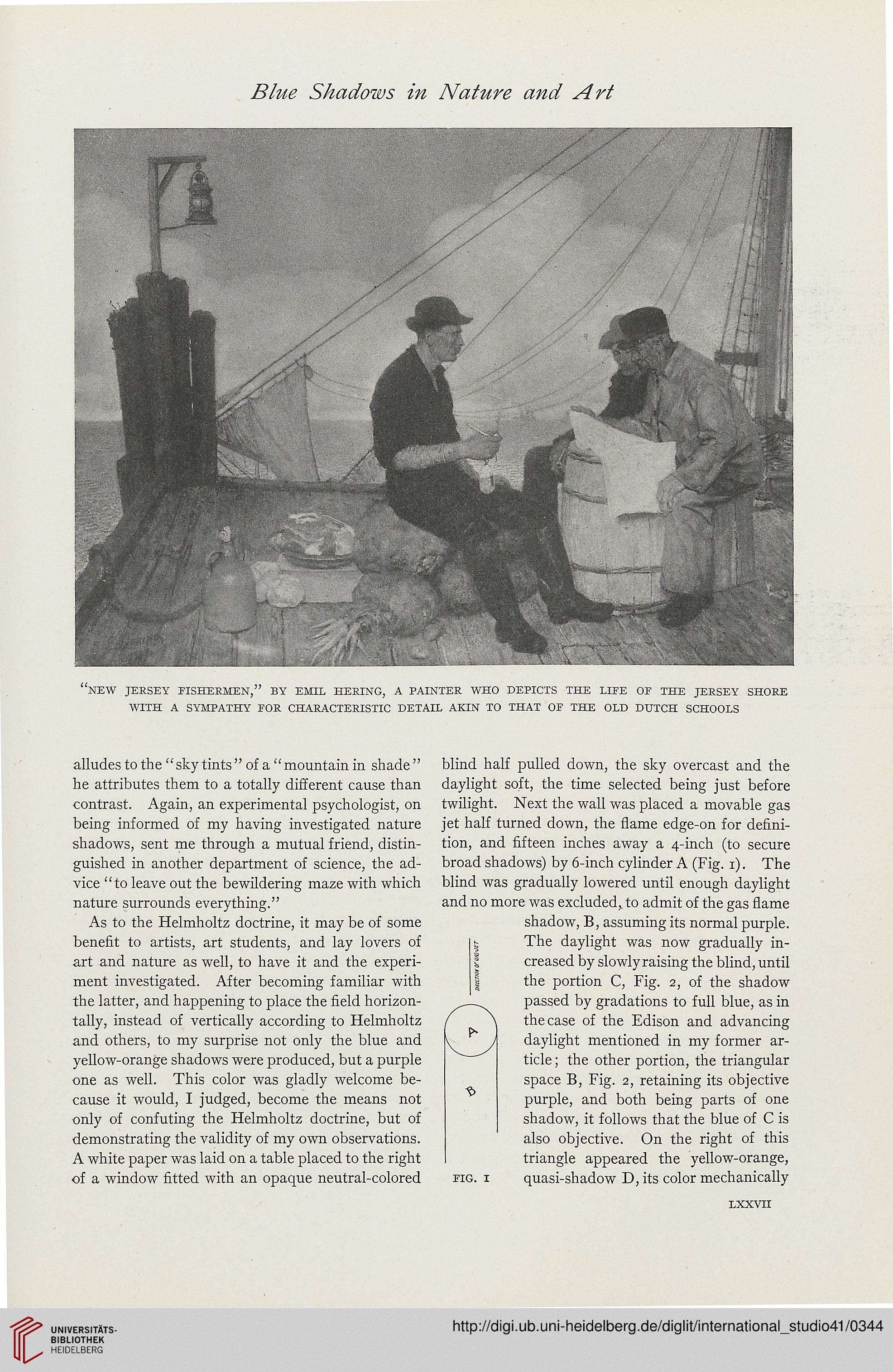Blue Shadows in Nature and Art
NEW JERSEY FISHERMEN, BY EMIL HERING, A PAINTER WHO DEPICTS THE LIFE OF THE JERSEY SHORE
WITH A SYMPATHY FOR CHARACTERISTIC DETAIL AKIN TO THAT OF THE OLD DUTCH SCHOOLS
alludes to the "sky tints " of a " mountain in shade "
he attributes them to a totally different cause than
contrast. Again, an experimental psychologist, on
being informed of my having investigated nature
shadows, sent me through a mutual friend, distin-
guished in another department of science, the ad-
vice "to leave out the bewildering maze with which
nature surrounds everything."
As to the Helmholtz doctrine, it may be of some
benefit to artists, art students, and lay lovers of
art and nature as well, to have it and the experi-
ment investigated. After becoming familiar with
the latter, and happening to place the field horizon-
tally, instead of vertically according to Helmholtz
and others, to my surprise not only the blue and
yellow-orange shadows were produced, but a purple
one as well. This color was gladly welcome be-
cause it would, I judged, become the means not
only of confuting the Helmholtz doctrine, but of
demonstrating the validity of my own observations.
A white paper was laid on a table placed to the right
of a window fitted with an opaque neutral-colored
blind half pulled down, the sky overcast and the
daylight soft, the time selected being just before
twilight. Next the wall was placed a movable gas
jet half turned down, the flame edge-on for defini-
tion, and fifteen inches away a 4-inch (to secure
broad shadows) by 6-inch cylinder A (Fig. 1). The
blind was gradually lowered until enough daylight
and no more was excluded, to admit of the gas flame
shadow, B, assuming its normal purple.
^ The daylight was now gradually in-
creased by slowlyraising the blind, until
the portion C, Fig. 2, of the shadow
passed by gradations to full blue, as in
f \ the case of the Edison and advancing
daylight mentioned in my former ar-
ticle ; the other portion, the triangular
space B, Fig. 2, retaining its objective
purple, and both being parts of one
shadow, it follows that the blue of C is
also objective. On the right of this
triangle appeared the yellow-orange,
fig. 1 quasi-shadow D, its color mechanically
LXXVII
NEW JERSEY FISHERMEN, BY EMIL HERING, A PAINTER WHO DEPICTS THE LIFE OF THE JERSEY SHORE
WITH A SYMPATHY FOR CHARACTERISTIC DETAIL AKIN TO THAT OF THE OLD DUTCH SCHOOLS
alludes to the "sky tints " of a " mountain in shade "
he attributes them to a totally different cause than
contrast. Again, an experimental psychologist, on
being informed of my having investigated nature
shadows, sent me through a mutual friend, distin-
guished in another department of science, the ad-
vice "to leave out the bewildering maze with which
nature surrounds everything."
As to the Helmholtz doctrine, it may be of some
benefit to artists, art students, and lay lovers of
art and nature as well, to have it and the experi-
ment investigated. After becoming familiar with
the latter, and happening to place the field horizon-
tally, instead of vertically according to Helmholtz
and others, to my surprise not only the blue and
yellow-orange shadows were produced, but a purple
one as well. This color was gladly welcome be-
cause it would, I judged, become the means not
only of confuting the Helmholtz doctrine, but of
demonstrating the validity of my own observations.
A white paper was laid on a table placed to the right
of a window fitted with an opaque neutral-colored
blind half pulled down, the sky overcast and the
daylight soft, the time selected being just before
twilight. Next the wall was placed a movable gas
jet half turned down, the flame edge-on for defini-
tion, and fifteen inches away a 4-inch (to secure
broad shadows) by 6-inch cylinder A (Fig. 1). The
blind was gradually lowered until enough daylight
and no more was excluded, to admit of the gas flame
shadow, B, assuming its normal purple.
^ The daylight was now gradually in-
creased by slowlyraising the blind, until
the portion C, Fig. 2, of the shadow
passed by gradations to full blue, as in
f \ the case of the Edison and advancing
daylight mentioned in my former ar-
ticle ; the other portion, the triangular
space B, Fig. 2, retaining its objective
purple, and both being parts of one
shadow, it follows that the blue of C is
also objective. On the right of this
triangle appeared the yellow-orange,
fig. 1 quasi-shadow D, its color mechanically
LXXVII




